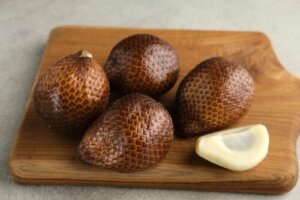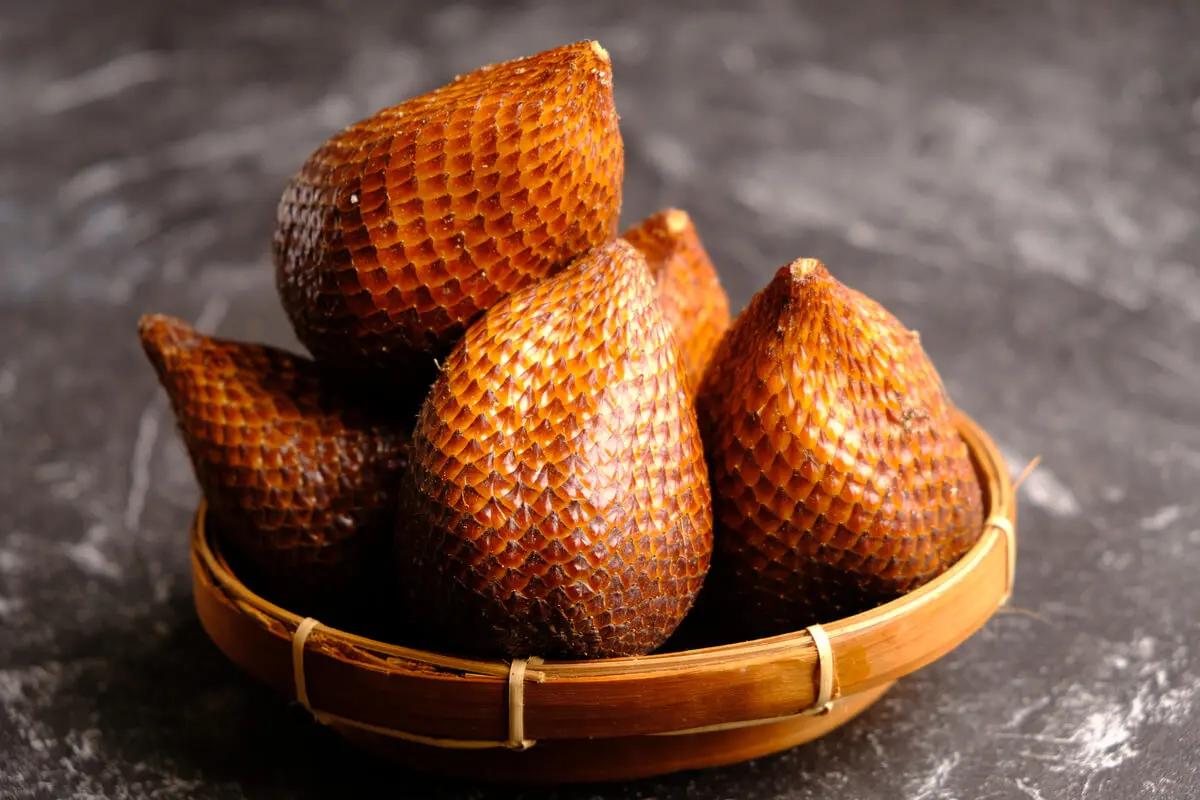Salak or Snake Fruit: Characteristics and Benefits


Written and verified by the nutritionist Maria Patricia Pinero Corredor
Salacca zalacca is the scientific name of an exotic fruit of oriental origin also known as salak, snake fruit, or cayigo. All the nicknames are due to the appearance of its skin. It’s widespread in Southeast Asia and certain tropical countries.
It’s known for its pharmacological benefits, thanks to its antioxidant properties and it’s also very nutritious. Its exquisite flavor makes it a favorite in Asian gastronomic culture.
Origin of the salak or snake fruit
According to Janick and Paull’s encyclopedia, the salak comes from a species of palm from the Arecaceae family, and has been cultivated by the Indonesians since 1500. It grows wild and can bear fruit for up to 50 years.
A group of experts says the fruit is native to Indonesia, but has since spread throughout Southeast Asia, to countries such as Malaysia, Thailand, and Myanmar. It has also spread to the Philippines, Australia, China, Suriname, and Spain.
On the American continent, it arrived for the first time in Ecuador, predominantly in the Amazon area, in the provinces of Napo, Sucumbios and Orellana, as it develops better under the climatic conditions of the tropics.
Salak characteristics
The Salacca zalacca is a species of small palm tree with a very short stem. Its leaves have thorns and the fruits grow at the base of the palm.
A botanical specialist reports that the salak grows in clusters of 15 to 40 fruits and there are different varieties. They’re covered with a brown skin with small spines, similar to a snake’s scales.
The Bali salak variety has a reddish-brown hue and the texture of its skin also resembles a snake’s skin. The flesh is white with a beige hue and has 3 lobes containing the seeds.
Its taste ranges from sour to sweet with a crunchy texture. In addition, it’s astringent when green and as it matures it becomes sweeter.
The yellow salak has a texture and flavor similar to the Bali, but its skin is yellow with golden tones. It has a delicate and soft pulp, sour taste and is very juicy.
Read also: 4 Exotic Fruits and Vegetables You’ve Probably Never Heard Of
Nutritional properties
Cueva and Pizarra analyzed the nutritional characteristics of the salak, finding excellent amounts of vitamins and minerals, in addition to a high fiber intake per 100 grams (4 oz) of fruit as follows:
- Moisture: 81.29 grams.
- Protein: 0.69 grams.
- Total carbohydrates: 17.11 grams.
- Fiber: 16.55 grams.
- Fat: 0.34 grams.
- Phosphorus: 1169 milligrams/kilo.
- Potassium: 1339 milligrams/kilo.
- Calcium: 220 milligrams/kilo.
- Magnesium: 607 milligrams/kilo.
- Iron: 12 milligrams/kilo.
- Zinc: 104 milligrams/kilo.
- Vitamin C: 400 milligrams/kilo.
- Vitamin B2: 6.32 milligrams/kilo.
- Niacin: 240 milligrams/kilo.
- Vitamin B1: 20 milligrams/kilo.
One review highlights that salak contains more phytochemicals than other exotic fruits. In addition, it also contains sugars that give it a sweet taste when ripe.
The same review mentions compounds with pharmacological properties. It contains flavonoids, phenolics, gallic acid and many other antioxidants.

The benefits of salak or snake fruit
The nutrients and phytochemicals contained in salak can improve some health problems and the fruit can be used in other industrial areas.
Antioxidant properties
The intake of antioxidants with food can combat the activity of free radicals in the body. Several laboratory tests have found a good antioxidant capacity in salak pulp, due to the presence of vitamin C.
Also, another study characterized the polyphenol content of salak and its antioxidant power in rats with high cholesterol. When supplemented with snake fruit pulp, a significant reduction in plasma lipids was observed.
Not only the pulp has antioxidant capacity. Research revealed that the skin of snake fruit also contains enough polyphenols to increase its antioxidant potential.
It may help to control type 2 diabetes
A group of experts found that the glucose level decreases with small amounts of salak vinegar. In addition, it was able to regenerate damaged pancreatic cells in experimental rats.
Science also found that this fruit has an inhibitory effect on certain digestive enzymes. This helps to decrease glucose absorption in type 2 diabetic patients. However, more human studies are needed to corroborate the effect.
It may stabilize elevated uric acid levels
A review refers to the presence of two compounds in snake fruit: beta-sitosterol and methyl ester, related to gout relief. However, methyl ester was more efficient in preventing the formation of uric acid crystals.
Read all about uric acid here: Uric Acid: What Is It and How Can You Control It?
It may prevent chronic diseases
Although more human studies are needed, the journal Journal of Functional Foods has published an article which states that the presence of some antioxidants in salak fruit may have an anti-cancerous effect. They also report that these antioxidants may prevent heart disease, strokes, and menopausal symptoms.
Other properties
Snake fruit is used in the food industry to isolate yeast used in bread making. This yeast has a better fermentation capacity than traditional yeast and gives it a good crust and crumb color development.
Fruit teas can be made by combining it with pineapple, for example. Some food technologists have found the optimal formula in a ratio of pineapple, salak, and logan of 20:20:60 to develop a healthy and potent drink.

Gastronomic uses of salak
In a book published by Paull and Duarte we can find some recipes made with salak. The authors report that ripe salak has a sweet or sour-sweet taste that pleases most palates.
Other consumers prefer to prepare them raw, but most make them into preserves, jams, jellies, juices, syrups and candies. When dried, they’re eaten as chips.
In Thailand, a curry mixture is prepared with this fruit, and in Malaysia they make dumplings. The consistency of the snake fruit makes delicious cakes and it’s even recommended for weight loss.
In Ecuador, the indigenous people eat it as a fresh ripe fruit. In Asia, the ripe fruit is used as a raw material to make vinegar and wine.
Does the salak have contraindications?
If you’re eating snake fruit for the first time, then should be careful with tolerance. We recommend that you only try a small piece and wait. If it doesn’t cause any adverse reactions then go ahead and eat it, but never in excess.
Never combine green salak with milk. If you have constipation, don’t consume the green fruit. The presence of tannins, which are astringent, decrease intestinal motility and cause obstruction.
All cited sources were thoroughly reviewed by our team to ensure their quality, reliability, currency, and validity. The bibliography of this article was considered reliable and of academic or scientific accuracy.
- Mongkontanawat, N. Product development of fruit tea mixed with “Hed Krang” (Schizophyllum commune). Journal of Agricultural Technology 2013 Vol. 9(7):1665-1676.
- Janick J, Paull RE. Salacca zalacca -salak. En: los enciclopedia de frutas y nueces. 2nd eds. Estados Unidos: publicación CABI; 2008, pág. 153-15
- Sukewijaya, I., Rai, I., & Mahendra, M. (2009). Asian Journal of Food and AgroIndustry. Obtenido de Development of salak bali as an organic fruit:
http://www.ajofai.info/abstract/development%20of%20salak%20bali%20as%20
an%20organic%20fruit.pdf - Yahia, Elhadi M. Postharvest Biology and Technology of Tropical and Subtropical Fruits: Mangosteen to White Sapote. 06/30/2011, 536 páginas.
- Cueva D, Pizara C. Análisis bromatológico de los frutos de Salacca zalacca (Arecaceae) y de couroupita guianensis (Lecythidaceae). Repositorio Institucional de la Universidad Politécnica Salesiana de Ecuador. Tesis, Ing, Quito Ecuador, UPS, 7 p.
- I R Suica-Bunghez,S Teodorescu,I D Dulama,O C Voinea,S imionescu and R M Ion. Antioxidant activity and phytochemical compounds of snake fruit (Salacca Zalacca). IOP Conference Series: Materials Science and Engineering, Volume 133, International Conference on Innovative Research – ICIR Euroinvent 2016 19–20 May 2016, Iasi, Romania
- Hanna Leontowicz Maria Leontowicz Jerzy Drzewiecki Ratiporn Haruenkit Sumitra Poovarodom Yong-Seo Park · Soon-Teck Jung Seong-Gook Kang Simon Trakhtenberg Shela Gorinstein. Bioactive properties of Snake fruit (Salacca edulis Reinw) and Mangosteen (Garcinia mangostana) and their influence on plasma lipid profile and antioxidant activity in rats fed cholesterol. Eur Food Res Technol (2006) 223: 697–703 DOI 10.1007/s00217-006-0255-7.
- Sulaiman SF, Ooi KL. Antioxidant and α-glucosidase inhibitory activities of 40 tropical juices from Malaysia and identification of phenolics from the bioactive fruit juices of Barringtonia racemosa and Phyllanthus acidus. J Agric Food Chem. 2014 Oct 1;62(39):9576-85. doi: 10.1021/jf502912t. Epub 2014 Sep 22. PMID: 25198055.
- Haruenkit R, Poovarodom S, Leontowicz H, Leontowicz M, Sajewicz M, Kowalska T, Delgado-Licon E, Rocha-Guzmán NE, Gallegos-Infante JA, Trakhtenberg S, Gorinstein S. Comparative study of health properties and nutritional value of durian, mangosteen, and snake fruit: experiments in vitro and in vivo. J Agric Food Chem. 2007 Jul 11;55(14):5842-9. doi: 10.1021/jf070475a. Epub 2007 Jun 13. PMID: 17567034.
- Fang Li, Sha Li, Hua-Bin Li, Gui-Fang Deng, Wen-Hua Ling, Shan Wu, Xiang-Rong Xu, Feng Chen, Antiproliferative activity of peels, pulps and seeds of 61 fruits, Journal of Functional Foods, Volume 5, Issue 3, 2013, Pages 1298-1309, ISSN 1756-4646, https://doi.org/10.1016/j.jff.2013.04.016.
- Mohammed S. M. Saleh, Mohammad Jamshed Siddiqui, Siti Zaiton Mat So’ad, Fatimah Opeyemi Roheem, Salima Saidi-Besbes, Alfi Kh.atib. Correlation of FT-IR Fingerprint and α-Glucosidase Inhibitory Activity of Salak (Salacca zalacca) Fruit Extracts Utilizing Orthogonal Partial Least Square. Molecules, 2018,23(6), 1434;https://doi.org/10.3390/molecules23061434
- Lasekan O, Abbas KA. Distinctive exotic flavor and aroma compounds of some exotic tropical fruits and berries: a review. Crit Rev Food Sci Nutr. 2012;52(8):726-35. doi: 10.1080/10408398.2010.507910. PMID: 22591343.
- Paull, R. E., Duarte, O. Tropical fruits, Volume 2. 2012. SBN 9781845937898 DOI 10.1079/9781845937898.0000
This text is provided for informational purposes only and does not replace consultation with a professional. If in doubt, consult your specialist.








